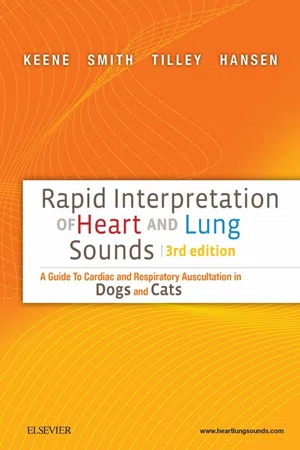
Rapid Interpretation of Heart and Lung Sounds
A Guide to Cardiac and Respiratory Auscultation in Dogs and Cats
- 112 pages
- English
- ePUB (mobile friendly)
- Available on iOS & Android
Rapid Interpretation of Heart and Lung Sounds
A Guide to Cardiac and Respiratory Auscultation in Dogs and Cats
About this book
Composed of a website and a companion book, this package demonstrates how to do accurate clinical evaluations of the heart and lungs in the examining room. The website offers step-by-step instructions on how to identify, interpret, and differentiate heart and lung sounds in dogs and cats. Made by using a heart sound simulator as well as recordings from patients, the website also covers heart murmurs and arrhythmias.The book expands on the website content and offers clear, concise illustrations of electrocardiograms (ECGs) and polarcardiograms (PCGs). It also includes pretests and post-tests to ensure thorough understanding of the material, as well as content on properties of sound, the stethoscope, and keys to successful auscultation.- Heart sound simulator allows you to focus on the heart sounds without the distraction of respiratory sounds or artifacts of hair rubbing against the stethoscope.- Wide variety of heart and lung sounds provides you with real-life cases that are as close to clinical practice as possible.- Pretests may be taken prior to reviewing the book and website to measure how much you already know.- Posttests help determine when the material has been mastered and direct the user to remediation in areas where additional study is needed.- Inclusion of clinically-relevant conditions makes it easy for you to apply this information to day-to-day practice.- Key points called out within the text alert you to potential problems, variations on techniques, and other treatment considerations. Lung sounds added Many more heart sounds Section on murmurs and arrhythmia expended Intros for each sound on the companion website have been expanded to provide more information
Frequently asked questions
- Essential is ideal for learners and professionals who enjoy exploring a wide range of subjects. Access the Essential Library with 800,000+ trusted titles and best-sellers across business, personal growth, and the humanities. Includes unlimited reading time and Standard Read Aloud voice.
- Complete: Perfect for advanced learners and researchers needing full, unrestricted access. Unlock 1.4M+ books across hundreds of subjects, including academic and specialized titles. The Complete Plan also includes advanced features like Premium Read Aloud and Research Assistant.
Please note we cannot support devices running on iOS 13 and Android 7 or earlier. Learn more about using the app.
Information
Heart Sounds
Pretest 1
Table of contents
- Cover image
- Title page
- Disclaimer
- Table of Contents
- Copyright
- Dedication
- Your Complete Learning Experience!
- Preface
- Acknowledgments
- Resource Contents
- 1 Heart Sounds
- 2 Murmurs
- 3 Arrhythmias
- 4 Lung Sounds
- Appendix 1 Canine and Feline Breed Predilections for Heart Disease*
- Appendix 2 Recommended Readings
- Appendix 3 Answers to Pretests and Posttests
- Index